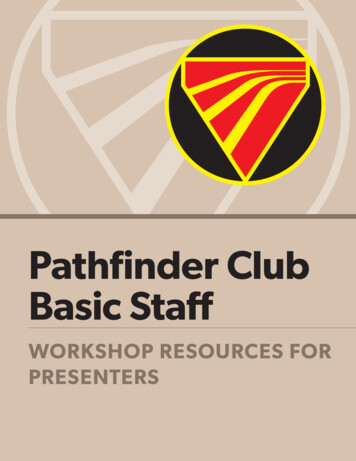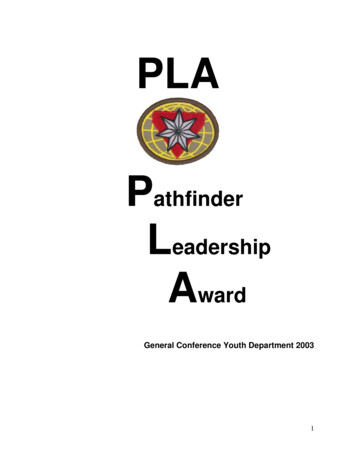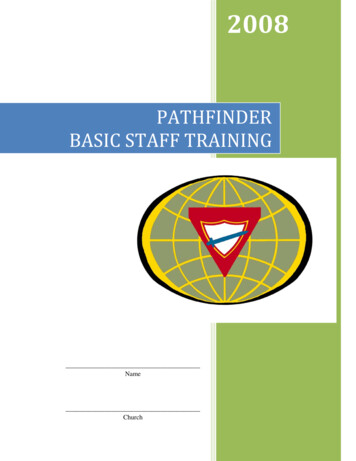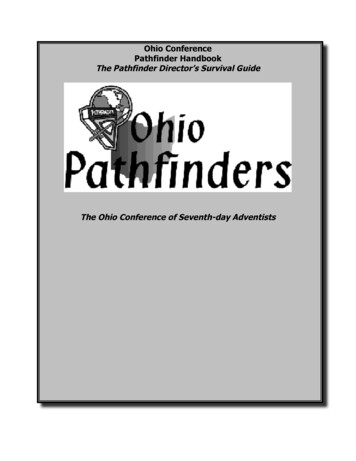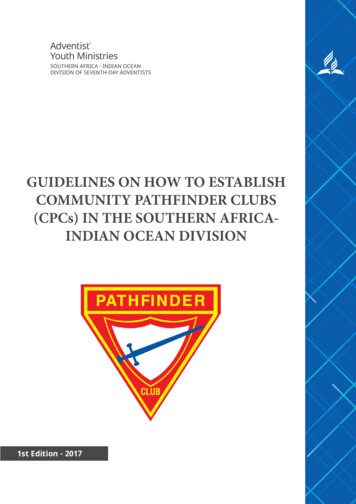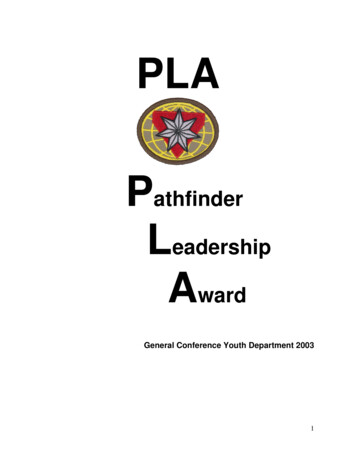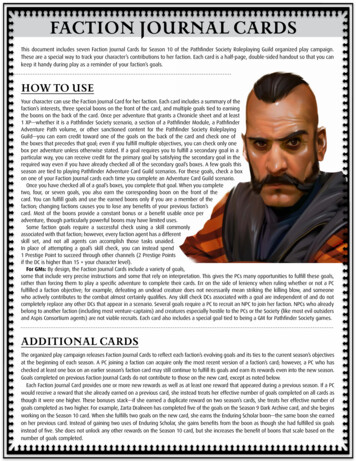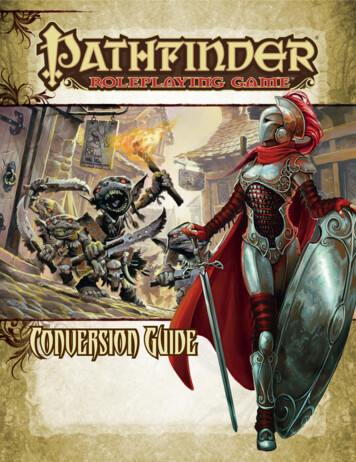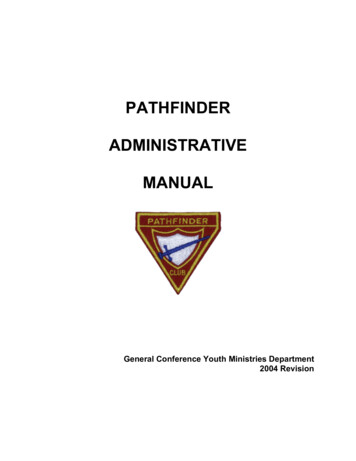
Transcription
PATHFINDERADMINISTRATIVEMANUALGeneral Conference Youth Ministries Department2004 Revision
nderstanding the Pathfinders and Staff3458Section A- Pathfinder Club StructureOrganizationPathfinder Pledge, Law, & EmblemMeaning of the Pathfinder Club EmblemSteps in Organizing a Pathfinder ClubPathfinder Club ConstitutionElection of Officers and StaffDuties of Officers and StaffPathfinder Area/District CoordinatorCommittee MembersMembershipPathfinder Club ApplicationApproval By Parents/GuardiansUniformPathfinder Excellence AwardMerit System--Philosophy of Merit SystemMerit Point AllocationGeneral RegulationsAbsences, Tardies, and RefundsUnit ReportFinancesFund-raising PolicyPathfinder Income and Expense JournalSample of Pathfinder Club 5676971727374Section B – Administration82Maintaining the Pathfinder ClubDisciplinePublic RelationsInsurance82858991Section C–Programming992
Pathfinder ClassesEnrollment NightSpecial Services and CeremoniesYearly ProgramPlanning GuideInvestiture Service99102103109114117Section D–Activities124Social Development--Philosophy of Social Education?RecreationSteps in Building a Successful Craft ProgramNature ion E--Conference Events183Pathfinder FairPathfinder RallyPathfinder CamporeePathfinder DayOther Conference Sponsored Events183185187193199PhilosophyThe Seventh-day Adventist Church is committed to understanding young people andtraining its youth for leadership and service to humanity.The Pathfinder Club is a church-centered spiritual-recreational-activity program designedfor young people 10 to 15 years of age. Pathfindering appeals to this age group becauseits program features activities that meet their needs and interests. Much of the PathfinderClub program is built around physical action. This is because youth from 10 to 15 yearsof age are in a fast-growing physical stage of development. It is filled with action,adventure, challenge, group activities, and provides opportunities for the development ofnew attitudes and skills that produce personal growth, team or community spirit and asense of loyalty and respect for God, His Creation, and His church.While the Pathfinder Club exists primarily for youth, one of its basic purposes is to alsobring together parents and church members through active involvement with the club andits members. Here the so-called generation gap disappears as young and old worship,work, and play together in a bond of common experience. Meaningful relationships areforged as leaders and counselors join with Pathfinders in sharing, building confidence,and working together.3
The whole philosophy of Pathfindering is built on the premise that "children learn best byexample, rather than precept." As they see leaders and parents model spiritual and socialvalues, they too will aspire to develop high moral principles, loving and caring attitudes,and determination to excel in all their various pursuits.Young people learn most effectively in a positive, happy, and secure atmosphere. Theattitude of the club leaders is therefore a vital ingredient in guaranteeing the success andeffectiveness of this ministry to youth. A failure to listen to and understand the needs ofthe young people will only erect barriers to real spiritual growth and development and mayprove to be a contributing factor in making the church and its mission unattractive to theyouth.ObjectivesThis philosophy is an integral part of the club. The Pathfinder Club curriculum of sixclasses and nearly 250 Honors lies at the heart of the program. The following objectivescan be achieved as the club leaders seek to fulfill these.1.Help the young people to understand that God and His church love them,care for them, and appreciate them. As Pathfinders are accepted and affirmedthey will begin to appreciate the love of God revealed through the church and itsministry, and feel a need to be more committed to and involved with its program.2.Encourage Pathfinders to discover their own God-given potential and to usetheir gifts and abilities to fulfill God's expectations for them and the part they canplay in the great plan of salvation.3.Inspire young people to give personal expression of their love for God byuniting them together in various outreach activities.4.Make the number one priority of your club program the personal salvation ofevery Pathfinder. The Pathfinder age is a time when many decisions are beingmade that will affect the youth's future relationships and his or her own personaldevelopment. The peak time for discovering and making a relationship with Godseems to be around 12 years of age.5.Build into a Pathfinder's life a healthy appreciation and love for God'screation by enjoying outdoor activity (campouts, nature walks, nature honors,etc.). Pathfinders will experience a sense of wonder and worship as they observeand explore the beauty, the majesty, and the creative power in nature. Fellowshipwith God will become more meaningful.6.Teach Pathfinders specific skills and hobbies that will make their lives moremeaningful and will occupy their time with profitable accomplishments. Youngpeople experience satisfaction and delight as they use their hands to fashion4
useful articles from wood, plastic, steel, clay, felt and yarn and as they discoverhow things work and operate.7.Encourage the Pathfinder to keep physically fit. This is one important way tosafeguard against idleness and boredom. Teach children to care for their bodyand establish habits that will provide for their future happiness and usefulness (cf.2T 536, 537; Educ. 195).8.Give opportunity for the development of leadership by encouraging clubmembers to work together and share in leadership responsibility. This will teachthem to learn the lessons of obedience, discipline, resourcefulness, patriotism andthe processes of group dynamics.9. Seek to foster the harmonious development of the physical, social,intellectual, and spiritual life of the Pathfinder. The invigoration of mind andbody, the fostering of an unselfish spirit, the attention to recreational and culturalactivities, will provide stimulus for personal growth and act as an outlet for thatrestless energy, which is so often a destructive source of danger to the youngperson.LeadershipAdventist youth deserve leadership. "He who cooperates with the divine purpose inimparting to the youth a knowledge of God, and molding the character into harmony withHis, does a high and noble work. He awakens a desire to reach God's ideal, he presentsan education that is as high as heaven and as broad as the universe." Education p. 19.With such a challenge set before us we need earnestly to consider some basic leadershipqualities. A leader needs to:1.Live a Christ-centered life. It takes Christian leaders to produce Christian menand women. More than that, Pathfinder leaders should be men and women whoselives are marked by Christ-centered living. They must demonstrate what theyexpect youth to become. This experience will manifest itself in the cheerfulperformance of all known duty and a spirit of confidence and optimism in regard tothe building up of the kingdom of God on the earth.2.Really love youth. The only satisfactory motive for serving in the Pathfinder Clubis love for the growing youth. This love will not be so much expressed in word asin deed. It is easily conveyed to the heart of the Pathfinder when the adult gladlyshares his time, energy, and companionship with the formative youth. It is easilyunderstood by the youth in the programs planned for them and the patientunderstanding revealed when they face problems. This love will be expressed inperseverance even when the junior youth are unappreciative and seeminglyneglectful of the counsel given.5
3.Be optimistic and enthusiastic. A buoyant and pleasant personality is a greatasset to the Pathfinder leader. Enthusiasm is contagious, and boys and girlsquickly follow optimistic leadership. The successful leader emphasizes thepositive and supports the program with energy and dispatch.4.Be master of his emotions. The true leader is master of his emotions. Hispersonality moods show a balance. This may be accomplished through selfdiscipline, temperate living, faith and trust in God, and a sense of responsibility.Any outburst of ill temper, anger, or depression will destroy the proper image ofthe leader that the boy and girl should possess.5.Enjoy the out-of-doors. Much of the activity of the Pathfinder Club can becompleted in the out-of-doors. A successful Pathfinder leader will organize theclub program to take every opportunity of introducing club members to newexperiences to be found in the mountains, valleys, beaches, and along the lakesides and streams. Planned nature discovery, camping, and hiking expeditionswill bring new and fresh skills to the club.6.Understand the characteristics of junior youth. The Pathfinder age involvespre adolescent and early adolescent children. It is necessary that a successfulleader understand the factors and pressures affecting junior youth and thecharacteristics common to this age group. They need to remember the qualities ofleadership most desired by youth, these are understanding spirituality,knowledgeableness, and personality. It will be highly profitable to read books,make observations, and try to work in harmony with legitimate prevailing trendsrather than in direct opposition to them.7.Master diversified skills. Every skill mastered by a leader is an additional keythat may be used to unlock some closed heart. It is extremely valuable to beversatile and diversified in experiences so that one may always have somethingnew to introduce to his group. It is desirable that the leader shall go far beyondthe activities in which he leads his Pathfinders. A leader keeps ahead in hisdevelopment of skills. In each Pathfinder Staff Training Course a leader should beable to discover the joy of new experiences.8.Know how to organize. Any leader who achieves must know how to organize.The organizer sets up his goal, then evaluates all the factors that he may call uponto reach this goal. Next, he lays out certain definite steps that are to be taken inthe accomplishment of his task. He then delegates responsibility to those who arecapable, using as many persons and favorable factors as he has been able tomobilize. He then coordinates these allies and encourages progress step by stepuntil he has reached the objectives. This is organization.9.Maintain pleasant relations with fellow workers. This question of personalrelations is exceedingly important. The secret is brotherly love, preferring theother person above yourself. The counselor must learn to have pleasant relations6
with those who are his equals and who are serving on the same level. He must becapable of rejoicing in the success, promotion, or honor bestowed upon his fellowcounselors. Whatever success or honor is bestowed upon him should beaccepted with modesty and self-restraint. The leader must foster pleasantrelations with his superiors. No matter where we are today, there are those whoare superior to us in responsibility. We must do all we can to be loyal to them, towork in harmony and cooperation with them. If we have ideas that differ weshould talk the matter over with the superior personally instead of talking with ourfellow counselors or the Pathfinders. When a leader finds himself in a position ofsupervision he should have pleasant relations with those subordinate to him. Heshould not have any jealousy or express any partiality. His efforts should bedirected to the strengthening of each leader under his supervision. He shouldremember that the success of each subordinate is his success. He should alsoremember that he is responsible for the training of those under him to take hisplace.10. Have a commanding personality. In a Pathfinder Club a leader should have acommanding personality. This means that he should have a dignity that makes iteasy for the Pathfinders to discipline themselves. At the same time the leadershould have a warmth of presence that invites confidence and creates friendship.It is disastrous to have kindness without firmness. It is entirely out of place to havefirmness without kindness. A Pathfinder leader should be “love personified withthe firmness of a sergeant.”11. Develop a sense of humor. Every leader dealing with youth must have a Teensense of humor. There are many incidents that tend to irritate or upset a leader.Youth are apt to jest some adult mannerisms. A leader with a sense of humor willtake such things in stride. A curious odd Viking’s poem says:“Moderately wise a man should be not too crafty and clever. A learned man’sheart whose learning is deep seldom rings with joy.”12. Be resourceful and creative. It is essential that a leader be capable of reachinghis objectives even though obstacles and difficulties lie in the way.Resourcefulness will enable him to have alternate plans when the more desirableway is blocked. He will be quick to observe, logical in his thinking. A leader is aman or woman who finds a way, or makes one and is willing to let God work Hisplan through them.13. Enlist cooperation. As the leader of a group, you will find that your success isgoing to depend, not only upon yourself but on the cooperation of every personworking with you. If they do not cooperate you will not accomplish anything, nomatter how brilliant you may prove to be. Your problem, then, is to learn how toenlist their cooperation. Just how can that be done?a. Be friendly.b. Be generous with praise.7
c.d.e.f.g.h.i.j.k.l.m.n.o.Ask people's advice.Make people feel important.Never embarrass anyone.Lead, instead of drive.Learn to remember names.Keep your promises.Be happy and optimistic.Do not brag.Do not make a decision when emotionally upset.Heal all hurts at once.Choose capable helpers.Be a person of action.Be willing to cooperate with others.“Authority without wisdom is like a heavy ax without an edge: fitter tobruise than polish.”–Ann BradstreetUnderstanding the Pathfinder and StaffEARLY CHILDHOOD (1-6)Early childhood is a time of intense activity. We are constantly amazed at theamount of energy the child is able to get out of the food he eats. He lives in aworld of make-believe, and peoples it with strange and often fantasticcreatures. In quick succession he is likely to become a frog, a horse, or even afire engine. He is not yet able to distinguish between the real and theimaginary, and truly believes the big black dog is a bear. The difficulty oftransference from the unreal world of fantasy to the real world gives rise to theso-called lying that is prevalent at this age. He is filled with curiosity and isconstantly asking, "Why?" and "What for?" He is extremely imitative, and willpick up bad words and bad habits without knowing the significance of them.He wants to spend his time in active play rather than be amused, enjoysstories with jingle and rhyme, and insists on having them retold. He isextremely credulous, believing implicitly in what his parents and other trustedfriends tell him.MIDDLE CHILDHOOD (7-9)During middle childhood there is continued intense activity, but it is morecontrolled, and motivated by purpose. He is still curious and has manyquestions, which should be answered frankly, but reason is now beginning todevelop, and he draws conclusions from his own observation and thinking. Oldthings take on new meanings, and his world is daily becoming larger. Instead8
of fantasy, he wants stories that could have happened. Now he imitates thedoer, rather than the deed. He wants to be the engineer rather than theengine. He now wants companions, rather than play alone, but still isindividualistic. His attention span may be very short requiring frequentchanges in activity.PREADOLESCENCE (10-12)The junior age is full of noise and ceaseless activity, slow growth, andboundless health. Girls tend to be more developed than boys physically,mentally, and even somewhat emotionally. By the age of 12 this advance hasreached two years, but after this the boys begin to catch up, drawing even atabout 18-19 years old. There is a group tendency for independence and selfassertion. In school the children are quick to learn, and have an amazingpower to recall that which they have heard or studied. They now have a greatadmiration for people who are able to "do things," and thrive on hero stories. Itis during this period that children have a lively interest in religion. They find itnatural to turn to Christ and commit themselves to Him and His way of life.Mental Characteristics:1. Preadolescence is the golden age of memory. The mind is like wax forreceptiveness and like bronze for retentiveness. The preadolescent learnsrapidly and can memorize easily.2. The juniors at this age are alert, and very eager to investigate and learn.They like to take things apart and see how they are made. They like to buildmodels.3. They are lovers of stories and good books, and usually like to read.4. They have a real interest in collecting. Some educators estimate that 90percent of all children of this age collect one thing or another. They may begathering four or five different collections simultaneously. This is anexcellent time for studying Honors.5. This is not the age for specialization, but the Pathfinder Club should openup many avenues of interest to the club members. Since new interests arevital to this age, a three-month program on one craft or honor study issufficient6. Their attention span remains rather short and quickly become bored withlow-activity programming.Physical Characteristics:9
1. This is the healthiest period of life.2. The body and mind are well balanced for coordination. Games, marching,and skills are readily learned.3. This is a restless period when a child can't "sit still and be good." He has aninnate desire to exercise his lungs, which makes the conventionalities andconfines of a room too narrow for his boundless and boisterous activities.4. Someone has said, "There never seems to be any nice relaxed middleground in a child's behavior. He is either running at a wild clip or stoppeddead--and both strike fear in the breast of a parent."Social Characteristics:1. A Pathfinder of the preadolescent age likes secret codes and adventure.2. He is learning teamwork, but retains an independent spirit.3. Wanderlust is a natural impulse of this age, not a moral delinquency. It is anage of exploration, and imagination will produce wild animal imitations andscenes of wild adventure from ages past.4. This is an age of great hero worship and great credulity.5. Interest in the opposite sex is minimal. Boys prefer to be by themselves, andgirls choose their own "sets."Spiritual Characteristics:1. This is an age of keen interest in spiritual things and in the work of the church.2. This is the peak age of baptism (12).3. The Pathfinder at this age likes Share Your Faith activities and delights inaward pins, ribbons, etc.4. The quality of credulity makes this an easy age in which to give religious andmoral instruction.EARLY ADOLESCENCE (13-15)There is now rapid growth, which often brings with it an awkwardness, owing tolack of coordination of mind and body. It also causes embarrassment to theyoung people, because certain organs, such as the nose, mouth, and feet grow10
more rapidly than the rest of the body, making them "ugly ducklings" andbringing unexpressed fears that they will always be that way. The gang agenow reaches its height and begins to recede, being replaced by an interest insex, with accompanying bashfulness, at this stage. Mental developmentmakes definite gains, causing the young person to be critical rather thancredulous as he has been in the past. He gives much time to daydreamingand thinking about what he is going to be and do later on. He is definitelyaltruistic and is challenged to do worthwhile things in the world. Religiousinterest continues and spiritual things begin to become a matter of experience,rather than the acceptance of a lot of facts.Mental Characteristics:1. Youth is alert, but subject to daydreaming periods.2. Youth learns quickly.3. Youth begins to take interest in special areas.Physical Characteristics:1. The health is excellent, second only to the preadolescent period.2. Physical growth is very rapid, with tremendous appetite accompanying thisgrowth.3. Muscle development or coordination fails to keep pace with bone structuregrowth, causing a tendency toward awkwardness or clumsiness.4. Sex organs develop, making rapid changes biologically. New hormones thatdevelop sexual instincts influence behavior. Rousseau said: "We are borntwice, the first time into existence and the second time into life; the first time amember of a race and the second time a member of the sex."5. Girls average taller than boys at 12 to 13, slightly taller at 14, less at 15, and 2inches shorter at 16.Social Characteristics:1. This is an age of loyalty to gangs, with a fear of being different from the group.The Youth seeks the approval of the group for all activities.2. He seeks more individual freedom with a new discernment of the inwardqualities of individuals. Weigle remarks: "His vision penetrates the outward actand catches the spirit within a man. He begins to discern inward qualities and11
to feel the intrinsic worth of truth, faith, and self sacrifice. He is full of ambitionsand makes plans for the future."3. There is frequent change of mood. One time activity is manifested whileanother time, apathy. In the morning the early adolescent may be generous inhis impulses, while in the afternoon he may seem greedy. One hour he isastonishingly self-conceited, and another quite timid.4. These eccentricities manifest themselves in many ways:a.Strong likes and dislikes in foods; certain favorite foods excess.b.Great love for athletics, with a tendency to overdo.c.A crude sense of humor; girls tend to giggle.5. Those of this age group have an attraction for the opposite sex. This is adangerous age for sexual and social temptations, as the youth is not preparedfor individual courtship. Group activities should be sponsored for those of thisage. Careful chaperonage MUST be provided on all Pathfinder outings, e.g.field trips, Camporees, etc.Spiritual Characteristics:1. The interest in spiritual things wanes slightly at this age, but the youth isinfluenced by the attitudes of the group he is with.2. Thirteen is the age when the second--largest number of youth are baptized intoour church.3. This is an age when choice of one’s lifework is often determined. Theimportance of holding before these youth their destiny in finishing the work ofthe gospel is thus apparent.4. There is less tendency for this age group to demonstrate their feelings onspiritual matters or convictions.5. There are often conflicts with conscience.6. Interest in the service projects develops during this age.Middle Adolescence (16-17)Growth continues to be rapid, the young person in many cases reaching his fullheight by the end of this period. Whereas in the past he went through a period of12
self-discovery, the youth now begins to develop an individuality, and becomes aperson in his own right.Mental Characteristics:1. He is at an age where he will likely question everything and wants proof beforehe will accept it.2. He has a great respect for “scholarship” and is often inclined to take as ananswer something that is held to be the truth by someone with a big name.3. His ideals are now beginning to be shaped, and he is definitely planning how toattain them.Physical Characteristics:1. Sexual development, a force to reckon with.2. Height and weight at 85 percent of his adulthood.3. Muscle becomes developed and he likes physical fitness programs.Social Characteristics:1. He likes cliques and wants to be surrounded by his special friends.2. Critical, often brutally frank in his expressed opinion of others.3. Very sensitive, and often guided by public opinion and what his social groupthinks is the proper thing to do. . .4. Money making often grips youth of this age, resulting in advice to drop out ofschool.Spiritual Characteristics:1. He either goes forward, as a recognition of social and spiritual values becomeparamount or, by reason of wrong associates, he loses interest.2. What has not been done in giving him a foundation on which to base histhinking now becomes difficult to do.3. He begins the process of determining his own approach for religion.13
4. Service projects focus on what life is all about.Later Adolescence (18-24)Physically this is a time of slow growth; those late in maturing catch up with theothers. The personality emerges and character becomes fixed. Gregariousnessnow finds an expression, not in gangs or clues, but in clubs, fraternities, lodges,and the church. Whatever doubts there have been in connection with religionhave either been thought through and a satisfying basis for faith found, or there isthe casting off of religion as a relic of the past, with disillusionment resulting incynicism. Interest in sex has found expression in love and marriage, and thefounding of a home.Adult LifeEarly adult life is characterized by good health and the joy of living. There is theserious business of rearing a family, the struggle for social recognition, and theurge for economic security. There is the desire for increased responsibility inanticipation of creative labor, and the joy of greater accomplishments. Many aredriven by ambition to seek power and lord it over their fellows. The religious life,depending on past training, is either one of faithfulness and worthy service or oneof indifference, with a preference for personal relaxation.Middle adulthood finds many beginning to break in health. There is increasingworry and tension, perhaps because of great responsibilities or because of thefear of losing a job. Many adults become despondent because of hopesunrealized, and discovering it is too late to do anything about it, turn attention fromself and life in anticipation of the accomplishments of their children. On the otherhand, some who have been slow in maturing are just beginning to “find”themselves. Success for them lies not in the past, but in the future.Many studies have been conducted analyzing the variety of temperaments shownamong humans. Various efforts have been made to categorize these intounderstandable units. One well known effort is known as the TemperamentInventory Test which places a person into a combination of four boxes: Choleric,Sanguine, Phlegmatic, and Melancholic. Any person who wishes to be a leaderworking with a group of adult volunteers would do well to take one of these typesof tests and to invite others to do the same for the sake of better understanding ofone’s own strengths and weaknesses as well as understanding where others arecoming from in their working relationships.Understanding the EmotionsAll human beings look for recognition/acceptance, affection, achievement, newexperiences, and security. Seeking for these and the result of finding or notfinding them is played out in the emotions. We have been introduced to why14
people act as they do, we now turn to the emotions and learn how they feel.There are many emotions; and only the primary ones will be discussed; but all ofthem are tremendously important for they are the driving power that causeschoices to be made, acts to be done, and services to be rendered. It is easyenough to believe things, but only when people feel deeply about their convictionsare they led to do something about them.HatredBehind hatred may be envy, jealousy, greed, prejudice, fear, wrongs suffered, ora sense of frustration. It is a vicious, violent emotion, which desires to kill, and willdo so unless restrained by fear of the consequences.FearThis may come from a concern for one’s safety, or the welfare of others. Theremay be a fear of loss of health, money, reputation, soul or many minor things.This may be a good thing, provided it is not allowed to become a complex that mayhave a paralyzing effect on body and mind.Fear of the unknown has always had a terrific impact on people. Among theignorant it amounts to superstition, and can have disastrous consequences.Among the educated it has the tendency to slow down or completely frustrateactivity. A young man of fine personality, who has been used to meeting thepublic in a business way, became the leader of a young married people’s classand went out to make church calls. This he dreaded very much, and as he put it,“The distance from the car to the door seemed like a mile.” Why? It was a fear ofthe unknown. What kind of people lived behind that door? Would they be nice tohim or would they resent his call? But after they opened the door and welcomedhim, he was glad he had braved the unknown.AngerThis usually results from a.) frustration, such as not having one’s way, not gettingwhat is wanted, or the lack of obedience to one’s orders; b.) irritation, whichincreases with ill health; c.) an effort to cover up a feeling of inferiority, chagrin, ordefeat; d.) righteous indignation, which comes from a feeling that injustice hasbeen done.Giving vent to anger is not a pretty thing to see, nor is it a sign of strength.Solomon said, “He that is slow to wrath is of great understanding: but he that ishasty of spirit exalteth folly” and “He that is slow to anger is better than the mighty;and he that, ruleth his spirit than he that taketh a city” (Prov. 14:29; 16; 32).JoyHappiness is a transient experience that comes and goes with the changing tide ofhuman experience, but joy is an abiding quality of life. Jesus had joy and wasanxious that His disciples have it. “These things have I spoke unto you, that my15
joy might remain in you, and that your joy might be full.” (John 15:11), and pray theFather that such might be the case.SorrowThis
Pathfinder Rally 185 Pathfinder Camporee 187 Pathfinder Day 193 Other Conference Sponsored Events 199 Philosophy The Seventh-day Adventist Church is committed to understanding young people and training its youth for leadership and service to humanity. The Pathfinder Club is a church-centered spir itual-recreational-activity program designed
